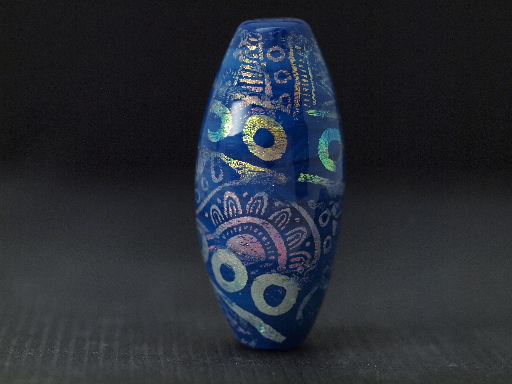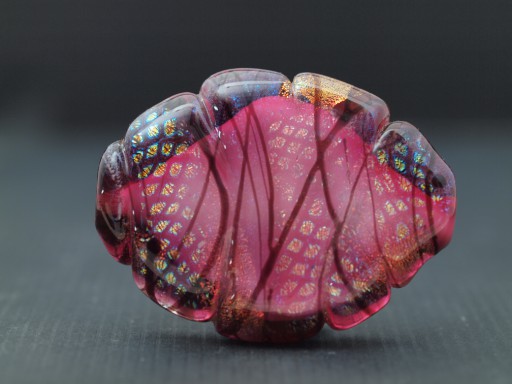This series has, more or less, been following the trajectory that I actually used to photograph the beads. I had an hour, more or less, to figure things out; and by the time I got to these last two beads, which Lisa had chosen last, I was getting (mentally) tired. Although not as physically demanding in terms of fine or continuous motor control as bead-making, studio photography, at least for me, can still be tiring.

Lisa St Martin. Opaque (probably periwinkle) cased in assorted patterned dichros, on a barrel bead roughly 2.5–3" high. Photoflood lighting.
This bead, because of its opaque core, did not have the tricky balancing issues that earlier ones did, so I wondered if I could just shoot it with photofloods and be done with it. The tonal range was also closer, meaning there was less likely to be blowouts in the dichro highlights. I tried it, and it looked okay.

Lisa St Martin, white cased in rubino, with patterned dichro and trailing. Approximately 2.5–3" long. Photoflood lighting.
This one was even easier, as it's relatively close, in terms of colour and tonal range, to beads I've shot in the past, in fact, among the earliest beads I ever photographed by another lampwork artist, those of my first teacher Peggy Prielozny.[1] I knew it would look good with standard incandescent photoflood lighting. So, why did I revert to the more wasteful, primitive technology?
Well, for a couple of reasons, the first being that it's wizziwig: what I see in the camera's (live) viewfinder is what I get. When I shoot flash I have to stop all the way down, possibly turn on a light, mebbe even the shutter speed way up to get enough light in the viewfinder even to focus; and I don't really know exactly what I'm gonna get till I actually take the picture. Oh, and remember to reset the f-stop and possibly shutter speed before I actually take the picture. Which of course I often forget to do.
On the other hand, I don't have to wait two seconds for the camera to settle down so I can take all three bracketing shots clickety-clickety-click.[2] So, from a production (i.e., needing to get the job done) point of view, there's advantages to each. Real pros have something called a modeling light that shuts off when the flash fires (so it doesn't contaminate the image) but I don't have that, and turning on and off my giftwrapping table light is a pest. (Which, ironically is why I prefer to shoot flash during the day, when ambient light is just enough to let me focus, but not so much as to mess up my photos, but take pix with photofloods at night, when considerably slower shutter speeds make stray sunshine coming in windows a problem.)
Yeah, I know. My life, as f2tY would say, is so hard.
But the other reason is that I had my own Lisa St Martin beads, and those, I knew I wanted to shoot with this kind of light, so I was just switching over a little early.
[1]You can also see very clearly how far digital photography, and, admittedly my own skills, have come in the last 15 years, which is about a century in dog/digital photography years.
[2]And, actually, I gather I should use something called mirror lockup, and wait five seconds to take slow-speed images. Live and learn...
Unless otherwise noted, text, image and objects depicted therein copyright 1996--present sylvus tarn.
Sylvus Tarn